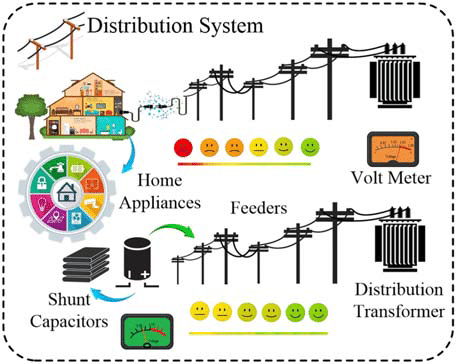Introduction
These are employed for reducing the voltage eithertomainingwnbt. Input to the transformer is high tension ( approximate 11 kV → 33 kV as primary ) and the output is step down secondary voltage which again near to user load voltage i.e in range of (120/240 V Residential or 480 V Commercial) We have seen that at maximum load for a distribution system, the voltage drop that occurs will still be within acceptable limits. This will of course be due to the regulation of the voltage of electricity to the various customers connected to a distribution system.
Types of Distribution Systems
A distribution system either radial (i.e., each element obtains power from a single source) or looped (i.e., more than one path to deliver power to the element which increases copiousness via collateral) Although underground systems are less susceptible to weather-related destruction, they are more expensive to install and maintain than overhead lines.
Distribution voltage levels
These transformers are used for stepping down the voltage to either the distribution system. The high voltage (11 kV to 33 kV approx as primary) serves the primary input, to convert and step-down the secondary voltage which again is near the user load voltage i.e. in the range of (120/240V Residential or 480V Commercial). Why it matters: Voltage regulation ensures that the electricity supplied to customers will always be at acceptable levels, regardless of the load on the system.
Distribution System Operation
The latter contains the operation & control from load shaping & balancing points of view to maintain the stability of the system. Fault detection isolation detect faults in timely fashions and isolates them to avoid large scale outages Regular maintenance and protocols for emergency response determine system re liability and safety.
Distribution Power Quality
Power quality is disturbed by voltage dip, swell and other phenomena that have impact on performance of electrical equipment. Harmonics due to non-linear loads makes power quality poor and they need to be filtered or treated using various methods.
Automation (and for some, Grid Automation to be specific)
Advanced Metering Infrastructure (AMI) as well as distribution automation systems are having a drastic impact on the nature of distribution systems. Using sensors and devices that can show real-time data, load can be controlled intelligently as well as the predictive maintenance. Likewise these technologies enable the incorporation of renewable energy solutions.
Distribution Systems Containing Robustness and Resilience
Reliability is calculated from the state of equipment, load fluctuation, weather etc. Resilience planning is following plan of recovery after a disruption (natural calamities). Then add climate change—now, extreme and more intense weather events are affecting distribution networks.
Renewable energy can help by doing the following:
Continued Though intermittent energy sources like solar and wind are very regenerative (they regenerate more energy than they take to extract), they do not integrate into the distribution system in the first place, and thus, cannot be extracted. Smart grid technologies have alleviated some of the variability problem and lower carbon electric generation has driven distributed generation due to the nes metering policy.
New Technologies and Practices
Electric micro-grids and innovative electric vehicles make the distributions of power more decentralized than ever before- starting a new chapter in power distribution. Strong emphasis on peak load compensation and renewable energy sourcing through batteries and different energy storage systems.
Safety Considerations
We embed electrical safety in the software to analyze power distribution systems. There are guidelines and protocols which ensure the safety of the public and the workers. At the same time, public awareness campaigns — and ongoing training for utility workers — help to keep safety top of mind during the course of day-to-day operations.
Conclusion
Handwritten on 0.15 mm dot grid paper with a mechanical pencil. Abstract Power distribution systems are complex systems consisting of numerous interconnected devices and components that need to be controlled and managed explicitly for reliable electricity supply Service. The automation systems, the transformers and conductors, the smart grid technologies, the renewable energy integration — every component is a key component. However, with changing technology, the distribution system must adapt to face the new challenges and possibilities. We hope in this guide, we were able to give you a broad insight into power distribution systems, and some information that makes you become eager to learn more about this vital area.




